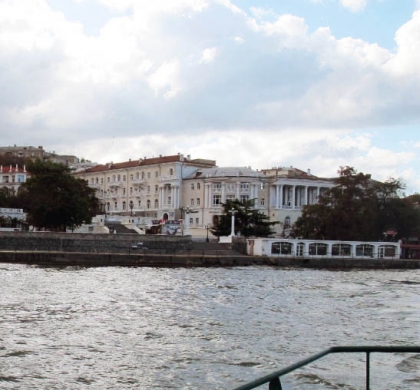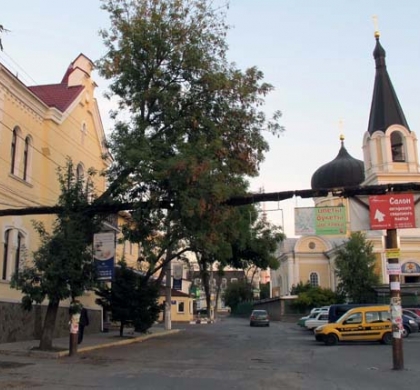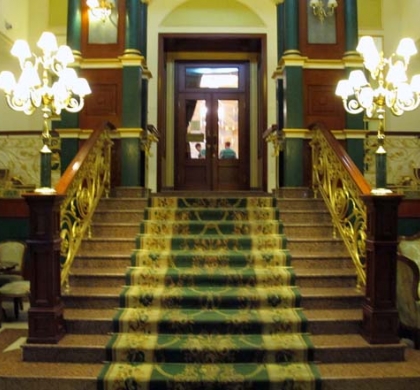Buy or gift a stand-alone digital subscription and get unlimited access to dozens of back issues for just £18.99 / $18.99 a year.
Please register at www.exacteditions.com/digital/cornucopia with your subscriber account number or contact subscriptions@cornucopia.net
Buy a digital subscription Go to the Digital EditionOn the Black Sea last summer (1992) Anthony Bryer found confusion in every port. In this extract from the unabridged version of an article published in Cornucopia 3, in 1993, he finds himself for two days in Yalta. How times have changed…
Wednesday: Salonica, Greece
Thessalonica, Solun, Slonki, Selanik – call the place what you will, there is always a slogan to puzzle over in Salonica airport. Before the fall of the Greek junta in 1974, it was GREECE FOR GREEK CHRISTIANS. This time it is MACEDONIA IS GREEK, accompanied by a US flag in blue and white. Alexander the Great, who went to some trouble to make Greece Macedonian, and after whose sister Thessalonike the city is named, would have been especially puzzled. As a non-Hellene he was initially barred from the Olympic Games, a slight that would not have bothered him much for, dammit, he was a god.
Macedonia was first subsumed in the EC in the form of the Roman Empire in 186BC, but the name refuses to lie down; it was given further identity in 1946 by the Yugoslav People’s Republic of Makedonija.
The Greeks object to others using the name Macedonia on copyright grounds: a foreign minister resigned recently on the matter. If this sort of nonsense goes on, the Bretons will complain about the British.
We travel by airport but a long a stretch of the Via Egnatia, which linked Old and New Rome (Istanbul), past the White Tower of Salonika to our cruise ship, the Orpheus…
Thursday: Mount Athos
The programme announces three hours of monastic voyeurism from 9am as we ‘close cruise’ the 20 monasteries, out-stations and hermitages of the Holy Mountain…
Friday: Gemlik, Turkey
This is a busy coastal town, with a cheerful band and good local olive oil for sale. Passengers are taken by coach to Iznik (Nicaea) in the morning and Bursa in the afternoon. I stay all day in Iznik, returning by excellent local bus along the Ascanian Lake (Iznik Gölü), because it is a favourite place: a quiet working Turkish town which has not burst out of the boundary of its ancient walls…
Saturday: Istanbul
The Yolcu Salonu, the passenger lounge, must be the most convenient place to moor in Istanbul, but what has happened to the Galata Bridge? It has become an exotic market: Russians selling improbable brands of vodka and Romanians selling themselves. This is no oriental bazaar, but the human detritus of upheavals to the north. I take an alternative excursion to the gasworks near the Golden Gate in Yedikule…
Sunday: The Black Sea
Even on board there is cultural confusion. Scheduled for 8am is the Anglican liturgy, held by an American canon in the upstairs bar, which Greek stewards have done their best to transform into a church…
Monday & Tuesday: Yalta, Crimea
The ship’s programme underlines: ‘No photography is allowed in or of Yalta Port’. Yalta Port is a handsome building, beneath the cliffs of the Yayla Mountains. Its only feature worth photographing is the Margate Restaurant: Yalta is convincingly twinned with that English resort. The Margate was closed, but beside it stood cohorts of gleaming Mercedes coaches, under the command of Eugenia. Eugenia is a queen of a new breed of entrepreneurs. She carries more gold than ever did Helen of Tory on her bosom, and her coaches return twice a year to Germany (West) for servicing. Intourist, crushed, were nowhere to be seen, but her coaches were equipped with former Intourist guides – and even loos.
Local guides are important people. For some they are the only human link between a foreigner in the back of a bus and the country they glimpse. Over 20 years, in Yalta and elsewhere, their patter has changed. It used to begin with a description of a state and ideology upon which the sun never set, which I had looked forward to. One sensed the common line, and relished the awkward moments. In Albania, where guides used to speak English with a Chinese accent, someone was bound to ask after a day or two what side of the road they drive on; only two years ago and 100km into Romania, an American lady asked incuriously why we had not yet seen a private car. But they are quick: the Romanian response was that everyone had private cars, but had driven them to the beach to drink beer, because it was such a nice day. I can’t remember which side the Albanians drive on, for we never met another car.
Of all local guides, the Turkish are the most engaging and self-confident. Reporting on his in 1555, the German ambassador OG de Busbecq said that: ‘The Turks have no idea of chronology and dates, and make a wonderful confusion of all the epochs of history; it if occurs to them to do so, they will not scruple to declare that Job was mast of ceremonies to King Solomon, and Alexander the Great his commander-in-chief.’ Turks assume that Frankish Ponentines (that is us) and all Christendom know their basic mythistory, just as Turkey and Islam know where they stand. So Turkish guides must find it a puzzle to take Christians who are ignorant around the sidtes of the Ecumenical Councils of Nicaea, Constantinople and Ephesus, and have to explain the mysteries of the creed. They have evolved a syncretic system that some gets back to Anatolia. I have watched Regius professors of theology and a future and past archbishop of Canterbury listen gravely to the proposition that the trinitarian definitions of the early Church derive from some Hittite past.
But the past in Yalta is more immediate: the trinity of Churchill, Roosevelt and Stalin only defined the post-war world in 1945. In the Livadia Palace, where they met, the confident patter of 20 years now falters and ask what pax think. Often pax can’t remember: it was all so long ago and didn’t touch them. But this time in Yalta I first heard a sort of anti-toast, ‘Yalta–Malta’ – when Bush and Gorbachev met in high seas. One sure palace survives: the Vorontsov at Alupka, built by Charles Blore. Indeed it was not until last year when I visited Blore’s Abbotsford, built for Sir Walter Scott, that I felt so at home in Crimea. It is not just the Scottish baronial, the gunroom, the only Hogarth painting in the Soviet Union, but the run of Punch magazine, unbroken throughout the Crimean War, which was waged a few miles away, and the ghosts of sequences of Scottish governesses who somehow gravitated to Crimea to bring up the Vorontsovs, and other liberal princes, even the family of their foe, the ferocious emir Shamyl of Daghestan. They had a club in Yalta and someone should write a history of them…
Exquisite bulbs, once uprooted in their millions, may be saved by a scheme to satisfy both gardeners and conservationists. Botanist Andrew Byfield reports
He was the most prolific architect of all time and his legacy endures in the great mosques created for Süleyman the Magnificent. Yet, as Brian Sewell discovers, this contemporary of Michelangelo is barely known to the West. Brian Sewell admires his legacy. Photographs by Ara Güler.
The Mocan Yalı, in the pretty village of Kuzguncuk, half a mile upstream from Üsküdar, is relatively old, decidedly large and incontrovertibly pink. Sultans stayed in it, and Liszt played in it. The yalı was purchased by the Toprak family shortly after this article was published. The interior of the house was gutted and only the facade remains. The images published in this article are a unique historical record of a centuries-old house and were taken by David George for Cornucopia in 1992
The Golden Fleece, Trebizond, Sumela… Jeremy Jame’s itinerary in Turkey’s dramatic Black Sea Mountains promised a string of ancient wonders
From chestnuts to walnuts, from pistachios to pine kernels, they are a mainstay of Turkey’s celebrated cuisine. Berrin Torolsan unearths some splendid traditional nut recipes.
More cookery features
The French novelist Pierre Loti caused a stir in the 1900s when he championed the cause of Turkish women. But just who were the three veiled women who gave him his information? Ömer Koç reports on an infamous literary deception
Unlike the much older Venice Biennale, at the Istanbul Biennial there was a feeling of youthful experimentation.
A storm one cold winter’s day in Rome brought Jean-Etienne Liotard to Istanbul. In a café where he took refuge from the rain, he met an Englishman, William Ponsonby, the future Earl of Bessborough, who invited the painter to join his party on a tour of the East. Liotard accepted, and they set sail from Naples on April 3, 1738.
The relentless bombing of Mostar (1992) is destroying the fruits of five centuries of peaceful coexistance in Bosnia. Marian Wenzel recalls how the old Ottoman city looked when she lived there in the Sixties




Cornucopia works in partnership with the digital publishing platform Exact Editions to offer individual and institutional subscribers unlimited access to a searchable archive of fascinating back issues and every newly published issue. The digital edition of Cornucopia is available cross-platform on web, iOS and Android and offers a comprehensive search function, allowing the title’s cultural content to be delved into at the touch of a button.
Digital Subscription: £18.99 / $18.99 (1 year)
Subscribe now